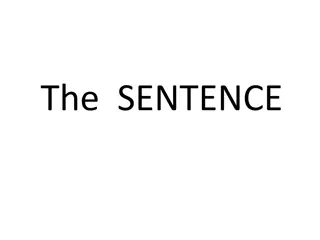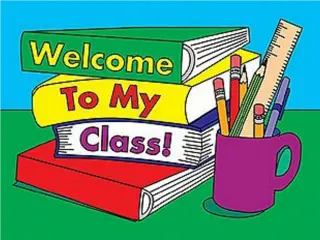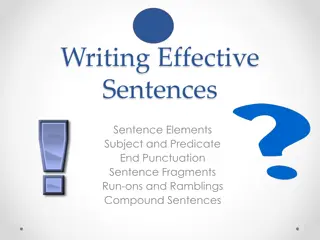Understanding Sentence Patterns for Effective Writing
Enhance your writing skills by learning the seven basic sentence patterns. Recognizing sentence patterns helps improve your ability to construct sentences effectively and understand grammar functions. Explore different patterns, such as the Be Pattern with adverbials and subject complements, Linking Verb Pattern, and Intransitive Verb Pattern. Practice exercises provided for each pattern to strengthen your grasp on sentence structure.
Download Presentation

Please find below an Image/Link to download the presentation.
The content on the website is provided AS IS for your information and personal use only. It may not be sold, licensed, or shared on other websites without obtaining consent from the author. Download presentation by click this link. If you encounter any issues during the download, it is possible that the publisher has removed the file from their server.
E N D
Presentation Transcript
SENTENCE PATTERNS
There are seven basic sentence patterns. Being able to recognize a variety of sentence patterns enhances your ability to use those patterns in your own writing and to understand better how grammar functions
Sentence Pattern 1: The Be Pattern (Adverbial) Adverbial modifies the verb (be) and answers questions like when, where, why, how. Slot 1 Slot 2 Slot 3 SUBJECT California BE is ADVERBIAL in the West US. Our final exam was yesterday. Swimming is for fun.
Exercise for Pattern 1 Identify the Adverbials 1. The performance will be next month. 2. Your teacher is on this campus. 3. Michael s only hope was for a short break.
Sentence Pattern 2: The Be Pattern (Subject Complement) Subject modifiers, or subject complements, explain or rename what the subject is. Slot 1 SUBJECT Slot 2 BE Slot 3 SUBJECT COMPLEMENT clever. (adjective) The students are Studying hard is important. I am an optimist. (noun phrase) Michael was an Olympic gold medalist.
Exercise for Pattern 2 Use the cues to finish each sentence with the specified type of subject complement: 1. Will you be (noun phrase)? 2. Shakespeare s writing was (adjective)! 3. Joshua isn t (noun phrase).
Sentence Pattern 3: The Linking Verb Pattern linking verbs other than be and a subject complement (which explains or renames what the subject is) Slot 1 Slot 2 Slot 3 SUBJECT LINKING VERB SUBJECT COMPLEMENT The pizza looks delicious. (adjective) The lake appears calm. My sister became a nurse. (noun phrase)
Most common linking verbs Senses: taste Smell Look Feel Sound Other Become Remain Seem Appear prove
Sentence Pattern 4: The Intransitive Verb Pattern involves only two components: a subject and an intransitive verb (an action verb that requires no complement) Slot 1 SUBJECT Mary The camera battery Dogs Slot 2 INTRANSITIVE VERB laughed. died. bark.
Intransitive verbs could certainly be accompanied by modifiers, too. E.g. The battery died suddenly. The audience laughed at the joke. However, this does not change the basic pattern. Some common intransitive verbs: sit stand walk run come work go play ...
Exercise Identify the boundaries in the following sentences; and then identify the pattern name E.g. The world of computers remains a mystery to my mother. The world of computers / remains / a mystery / to my mother. (Pattern 3 Linking words)
1. The breeze from the neighbors grill smells wonderful. The breeze from the neighbor s grill / smells / wonderful. (Pattern 3 linking verb) 2. Grace Kelly's co-star, James Stewart, was highly enthusiastic about working with her. 2. Grace Kelly's co-star, James Stewart,/ was / highly / enthusiastic / about working with her. (Pattern 2--to be + adjectival)
3. Certain types of food become contaminated if they are stored in an unsafe container. 3. Certain types of food / become / contaminated / if they are stored in an unsafe container. (Pattern 3--Linking verb) 4. Tomato plants grow as a series of branching stems, with a terminal bud at the tip that does the actual growing. 4. Tomato plants / grow / as a series of branching stems, / with a terminal bud at the tip that does the actual growing (Pattern 4 intransitive)
Pattern 5: The Basic Transitive Verb Pattern uses transitive verbs, which must be followed by a direct object (the person or thing receiving the action of the verb) Slot 1 SUBJECT My roommate Our secretary Dina Slot 2 TRANSITIVE VERB borrowed distributes spoiled Slot 3 DIRECT OBJECT my laptop. our weekly timesheets. her niece.
Exercise for Pattern 5 Determine whether the verbs below are transitive or intransitive. If a verb is intransitive, complete the sentence with a period. If a verb is transitive, complete the sentence by adding on a direct object. 1. Maggie contacted Maggie contacted me 3 times this week. 2. That novel completes That novel completes the series of his work 3. The ground shook The ground shook.
Pattern 6: The Transitive Verb + Two Complements (Type 1) The verb is followed by a direct object and an indirect object. (An indirect object is the object that is affected indirectly by the verb; the recipient of the direct object) Slot 1 Slot 2 Slot 3 Slot 4 SUBJECT TRANSITIVE VERB INDIRECT OBJECT DIRECT OBJECT Marie gave Ramon a birthday gift. The nurse handed the child a bar of chocolate. My father bought my sister a car. She made me a delicious cake.
When can we change the place of the direct/indirect object? E.g. Mary gave a birthday cake to Ramon. -- if we want to put the main emphasis on Ramon. -- if we want to add a modifier. (long modifiers are generally used at the end) E.g. Marie gave a birthday gift to Ramon, a friend from her old neighborhood in Northridge.
Exercise for Pattern 6 In the sentences below, identify the indirect objects (IO) and direct objects (DO): 1. David handed Terrance the ball when they were done playing catch. David handed Terrance the ball when they were done playing catch. 2. Give Cindy the notice once she leaves the meeting. Give Cindy the notice once she leaves the meeting. 3. Do scientists really administer animals human medicines for official testing? Do scientists really administer animals human medicines for official testing?
Pattern 7: The Transitive Verb + Two Complements (Type 2) a transitive verb, which requires a direct object to receive the action, as well as an object complement to modify or rename that object Slot 1 SUBJECT Slot 2 TRANSITIVE VERB considers calls Slot 3 DIRECT OBJECT the students me Slot 4 OBJECT COMPLEMENT The teacher My mum hard workers. a fool. Alternative use: The teacher considers the students to be hard workers.
Other verbs common to this pattern: make, prefer, elect, find I prefer my coffee black. Some students find grammar challenging. The teacher made the test too easy. California voters elected a movie start as their governor.
Exercise for Pattern 7 In the sentences below, identify the direct object (DO) and object complement (OC) of each verb and state whether it is a noun that renames or adjective that modifies the object. 1. The baker made the bread too chewy. The baker made the bread too chewy. 2. We elected him class president because of his speech. We elected him class president because of his speech. 3. The jury found him not guilty of murder in the first degree The jury found him not guilty of murder in the first degree
THE OPTIONAL ADVERBIAL The optional adverbial can also be added while analyzing sentence patterns. Egs (underlined are adverbials) During the Vietnam War, Gino s dad was a pilot. Because a weasel is wild, it should be approached with great caution. Yesterday the teacher called the students lazy when they complained about their assignment. This morning I got up early to study for my Spanish test.
Sentences without those adverbials are grammatically correct; adverbials add information! My friends and I have pizza regularly. My friends and I have pizza with persistent regularity. My friends and I have pizza for breakfast, lunch, and dinner nearly every day of the week. My friends and I have pizza whenever the mood strikes.
Exercise Use slashes to separate the units of the following sentences and then identify the sentence patterns: 1- be/adverbial 2-be/subject complement 3-linking verb 4-intransitive 5-basic transitive 6-transitive with two complements (direct/indirect) 7-transitive with two complements (direct/object complement
1. In 1747 a physician in the British navy conducted an experiment to discover a cure for scurvy. In 1747 / a physician in the British navy / conducted / an experiment / to discover a cure for scurvy. (basic transitive) 2. Scurvy was a serious problem for men at sea. Scurvy / was / a serious problem / for men at sea. (be/subj. complement) 3. Dr. James Lind fed six groups of scurvy victims six different remedies. Dr. James Lind / fed / six groups of scurvy victims / six different remedies. (transitive-two complements/direct- indirect)
4. When the men consumed oranges and lemons every day, they recovered miraculously. When the men consumed oranges and lemons every day, / they / recovered / miraculously. (intransitive) 5. Although fifty years passed before for the British Admiralty Office recognized Lind s findings, it finally ordered a daily dose of fresh lemon juice for every British seaman. Although fifty years passed before for the British Admiralty Office recognized Lind s findings, / it / finally / ordered / a daily dose of fresh lemon juice / for every British seaman. (transitive-two complements/direct-indirect)
6. Interestingly, Linds discovery also affected the English language. Interestingly, / Lind s discovery / also / affected / the English language. (basic transitive) 7. In the eighteen century, the British called lemons limes. In the eighteen century, / the British / called / lemons / limes. (transitive-two complements/direct-object complement) 8. Because of that navy diet, people call British sailors limeys. Because of that navy diet, / people / call / British sailors / limeys. (transitive-two complements/direct-object complement)























